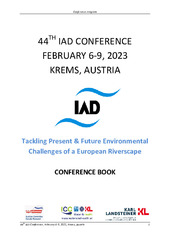Приказ основних података о документу
Joint Danube Survey 1 to 4: Concepts, Lessons Learned and Future Visions on Faecal Pollution and Antimicrobial Resistance
| dc.creator | Farnleitner, Andreas | |
| dc.creator | Schachner, Iris | |
| dc.creator | Jakwerth, Stefan | |
| dc.creator | Kittinger, Clemens | |
| dc.creator | Zarfel, Gernot | |
| dc.creator | Kavka, Gerhard | |
| dc.creator | Kolarević, Stoimir | |
| dc.creator | Kračun-Kolarević, Margareta | |
| dc.creator | Toth, Erika | |
| dc.creator | Blaschke, Alfred | |
| dc.creator | Derx, Julia | |
| dc.creator | Linke, Rita | |
| dc.creator | Demeter, Katalin | |
| dc.creator | Savio, Domenico | |
| dc.creator | Resicher, Georg | |
| dc.creator | Kir, Alexander | |
| dc.date.accessioned | 2024-03-22T11:11:58Z | |
| dc.date.available | 2024-03-22T11:11:58Z | |
| dc.date.issued | 2023 | |
| dc.identifier.uri | http://radar.ibiss.bg.ac.rs/handle/123456789/6596 | |
| dc.description.abstract | Sustainable and target-oriented microbiological water quality management of rivers needs information on whole river systems, especially if catchments are large and international. The microbiological water quality of rivers is of uttermost relevance for human health as river water is used for several purposes (recreation, drinking water production, irrigation). Besides information on faecal pollution levels, the origin of faecal pollution and the assessment of associated infection- and health risks, e g. from antimicrobial resistant bacteria (ARB) are of increasing importance. This contribution summarizes the concepts and main results from the Joint-Danube-Surveys (JDS) and discusses future challenges and perspectives (pollution-scenario modelling, infection-risk assessment) for the Danube River concerning its faecal and AMR pollution status. Between 2001 and 2019, the whole Danube was sampled four times during the JDS 1 to 4. Beside standard faecal indicator analysis, cutting-edge molecular detection concepts were applied, including microbial source tracking (MST) markers by quantitative PCR (qPCR) and high-throughput ampliconsequencing of bacterial communities. For AMR-profiling, clinically relevant bacterial species were isolated and tested for resistances and resistance genes were determined via qPCR. With this, we could impressively demonstrate that the JDS create the required multi-national “big picture” of the microbiological pollution status of the Danube River. Harmonised trans-border microbiological water quality maps for the whole navigable Danube were established. MST marker analysis elucidated that the main faecal pollution source along the whole river is human wastewater. Combined analysis of faecal indicators, MST and AMR-profiles provided a solid basis for assessing the potential health impacts of AMR associated with faecal pollution | sr |
| dc.language.iso | en | sr |
| dc.publisher | Austrian Committee - International Association for Danube Research | sr |
| dc.relation | Austrian Science Fund FWF (P25817, P32464) | sr |
| dc.relation | The International Commission for the Protection of the Danube River (ICPDR), | sr |
| dc.relation | The Austrian Federal Ministry for Sustainability and Tourism | sr |
| dc.relation | The Niederösterreichische Gesellschaft für Forschungsförderung GFF (LSC19-016) | sr |
| dc.rights | openAccess | sr |
| dc.source | Conference Book: 44th IAD conference: Tackling Present & Future Environmental Challenges of a European Riverscape; 2023 Feb 6-9; Krems, Austria | sr |
| dc.title | Joint Danube Survey 1 to 4: Concepts, Lessons Learned and Future Visions on Faecal Pollution and Antimicrobial Resistance | sr |
| dc.type | conferenceObject | sr |
| dc.rights.license | ARR | sr |
| dc.rights.holder | © 2023 by the Austrian Committee - International Association for Danube Research | sr |
| dc.description.other | Conference Book: 44th IAD conference: Tackling Present & Future Environmental Challenges of a European Riverscape; 2023 Feb 6-9; Krems, Austria. Austrian Committee - International Association for Danube Research; 2023. p. 9. | sr |
| dc.citation.spage | 9 | |
| dc.type.version | publishedVersion | sr |
| dc.identifier.fulltext | https://radar.ibiss.bg.ac.rs/bitstream/id/17055/2023_AbstractBook_44th_IAD_conf_Krems.pdf | |
| dc.citation.rank | M34 | |
| dc.identifier.rcub | https://hdl.handle.net/21.15107/rcub_ibiss_6596 |

